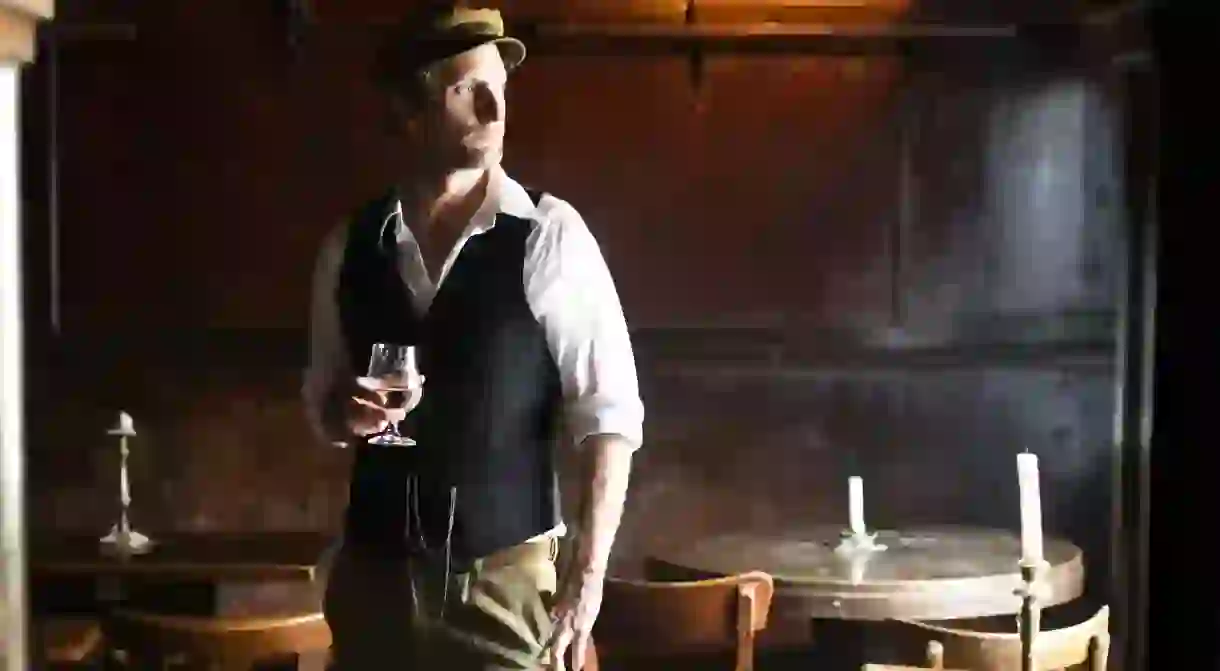A Time-Traveller’s Guide to Berlin With Arne Krasting

Want to glimpse the Roaring Twenties? Our in-the-know insider shares his tips on Berlin’s golden-era ballrooms, bars and boutique hotels.
Podcaster and author Arne Krasting is an expert on Berlin‘s Roaring Twenties. He acted in the period television series Babylon Berlin and now runs themed 1920s tours around the city under his Zeitreisen outfit, taking you to hidden filming locations and heyday hotspots of the Weimar Republic. Here, he shares the German capital’s most retro-glam places – which get even cosier during winter.
Zeitreisen
Building

“I’m a big fan of the Roaring Twenties – a period when Berlin was the cultural centre of Europe, at least for a brief moment. The nightlife here was legendary: Marlene Dietrich, Josephine Baker and Billy Wilder all partied here. I want to travel back in time with people to this glamorous era, and that’s why I offer tours of the city, themed all around this decade. Even my office at Chodowieckistrasse 10 looks like a little museum with furniture and objects of the time.”
Henri Hotel
Boutique Hotel

“Henri Hotel is a tribute to the art deco period. But more than that, it is a perfect symbiosis of the cosiness of the past and the elegance of the present. At the reception desk, there’s an illuminated globe and an old travel typewriter. You don’t have a card to enter your room, but rather a heavy key. I love the Orient Room, reminiscent of the opium dens of the time. Berlin, city of vice, city of sin!”
Clärchens Ballhaus
Bar, Restaurant, European, German, Austrian, Wine, Beer

“People were dancing in Clärchens Ballhaus 100 years ago. Today, it’s one of the coolest places in the city, and one of the few remaining ballrooms. The food is Berlin cuisine with a modern twist – try the boulettes (meatballs). On weekends, young and old, Berliners and tourists, classical-music lovers and techno fans come together on the dance floor and learn to swing dance. Famous movies like Inglourious Basterds or the German cult series Babylon Berlin, which I appeared in, were filmed upstairs in the Spiegelsaal (Hall of Mirrors).”
Bröhan Museum
Museum

Bar Tausend
Cocktail Bar, Bar, Restaurant, Fusion

“There’s no street number or sign to Tausend. It’s like a speakeasy-style bar from the Prohibition era. You have to know exactly where it is to find it – under the Friedrichstrasse train station. When you do, don’t come in sweatpants – the emphasis is on style and quality. There’s always live music, with international DJs or jazz bands. The bar menu is based on the most exciting districts in the world’s cities. Tausend was also a filming location for Babylon Berlin and though the interior is new, it fits wonderfully in the style of the 1920s.”
Provocateur Hotel
Budget Hotel

“Glamour and glitz: the Provocateur is the most extravagant hotel in town. As soon as you enter the lobby, you think you’re taking a trip back in time to a 1920s salon. With sofas in red velvet, glittery curtains and dim lighting, it could also be the set of a French noir – and has actually been used as a film location. Be sure to stop by the bar in the evening – the drinks are based on personalities from the Twenties. Occasionally, there are burlesque shows in the basement, too.”
Wintergarten
Theatre

“Variety shows and musicals were popular in the 1920s – and these traditions live on in the beautiful Wintergarten. Once you’ve walked the red carpet and passed the bar in the entrance, you’re in a breathtaking hall. Look at the ceiling: the light bulbs look like a starry sky. There’s a programme of shows throughout the year, featuring acrobatics, singing and dancing. Once a year, on New Year’s Eve, the most famous Twenties party takes place here: the Boheme Sauvage. See you on the dance floor?”
Babylon Berlin
Cinema

“This cinema is one of my favourite 1920s buildings in Berlin, at the Rosa-Luxemburg-Platz, where you’ll find several period residential houses. It’s been restored and looks like it did when it opened. It’s the only cinema in Germany where the old silent movie organ still works, and every Saturday at midnight it’s played to a silent movie – which you can watch for free. There’s also a silent-film orchestra here, playing to famous 1920s movies like Metropolis.”
Absinth Depot
Shop
Funkturm
Building

“Some call the Funkturm the ‘little sister’ of the Eiffel Tower. This radio tower is indeed somewhat smaller, younger and slimmer. But unlike its Parisian counterpart, however, it was really built for the radio. You can drive up and enjoy the view. Or, admire the great wood panelling from the 1920s in the panorama restaurant; that’s why Funkturm is listed in the book I wrote about the buildings of the Weimar Republic. From the top, you can also see the famous TV Tower in East Berlin.”













